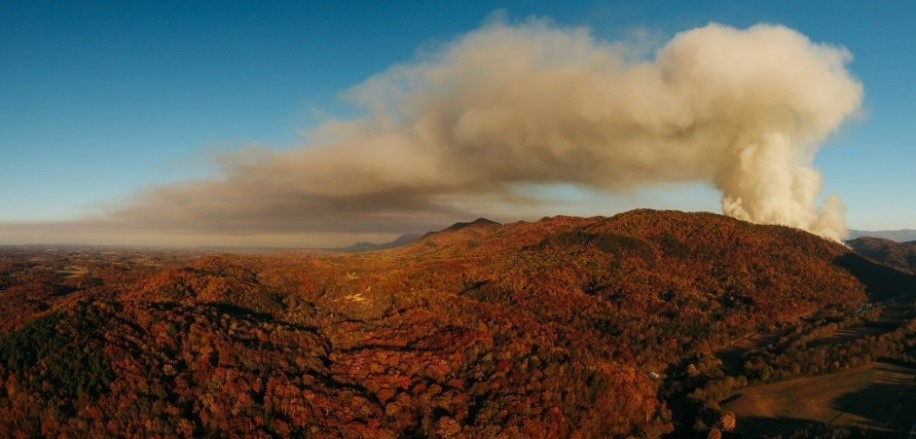Worker Protection from Wildfire Smoke

This web page provides an overview of Cal/OSHA's regulation to protect workers from wildfire smoke.
California Code of Regulations, title 8, section 5141.1 applies to most outdoor workplaces where the current Air Quality Index (current AQI) for airborne particulate matter 2.5 micrometers or smaller (PM2.5) is 151 or greater, and where employers should reasonably anticipate that employees could be exposed to wildfire smoke.
Wildfire smoke is composed of harmful chemicals and tiny particles suspended in the air that present a significant health hazard for workers exposed to it. These particles can irritate the lungs and cause serious or even fatal health effects, such as:
- Reduced lung function
- Bronchitis
- Worsening of asthma
- Heart failure
Which employers must comply with the regulation?
Employers with workplaces and operations must comply with the full standard when both of the following conditions apply:
- The current AQI for PM2.5 is 151 or greater, regardless of the AQI for other pollutants
- The employer should reasonably anticipate that employees may be exposed to wildfire smoke
Which employers are exempt from compliance with the regulation?
Employers with workplaces and operations in any of the following conditions are exempt from complying with section 5141.1:
- Enclosed buildings or structures in which the air is filtered by a mechanical ventilation system and the employer ensures that windows, doors, bays and other openings are kept closed, except when it is necessary to open doors to enter or exit.
- • Enclosed vehicles in which the air is filtered by a cabin air filter and the employer ensures that windows, doors and other openings are kept closed, except when it is necessary to open doors to enter or exit the vehicle.
- The employer demonstrates that the concentration of PM2.5 in the air does not exceed a concentration that corresponds to a current AQI of 151 or greater by measuring PM2.5 levels at the worksite in accordance with Appendix A
- Employees exposed to a current AQI for PM2.5 of 151 or greater for a total of one hour or less during a shift
- Firefighters engaged in wildland firefighting
What does the regulation require?
Section 5141.1 created the following requirements for employers to protect workers from wildfire smoke:
- Identification of Harmful Exposures (subsection c) – For worksites covered by the regulation, employers (with certain exceptions) must determine employee exposure to PM2.5 at the start of each shift and periodically thereafter, as needed.
- Communication (subsection d) – Employers must implement a system for communicating wildfire smoke hazards in a language and manner readily understandable by employees.
- Training and instruction information (subsection e and Appendix B) – For worksites covered by the regulation, employers must provide effective training that includes at least the information contained in Appendix B.
- Control of harmful exposures to employees (subsection f) – With certain exceptions, employers must reduce workers' exposure to wildfire smoke in the following ways:
- If feasible, by providing an enclosed location with filtered air so that employee exposure to PM2.5 is less than a current AQI of 151, or to the extent feasible.
- If that is not feasible or adequate, by relocating to another outdoor location where the current AQI for PM2.5 is lower, changing work schedules, reducing work intensity, or providing more rest periods.
- With respiratory protective equipment if employers cannot reduce workers' exposure to PM2.5 to a current AQI of less than 151.
- Where the current AQI for PM2.5 is from 151 to 500, employers must provide a sufficient number of NIOSH-approved particulate respirators, such as N95 masks, to all employees for voluntary use, and training on the regulation, the health effects of wildfire smoke, and the safe use and maintenance of respirators.
- Where the current AQI for PM2.5 is higher than 500, the employer must provide and require employees to use NIOSH-approved particulate respirators that will reduce employee exposure to PM2.5 to an equivalent of an AQI less than 151.
Determining Current AQI and PM2.5 levels
Employers may use the Air Quality Index or their own direct reading instruments to determine employee exposure to wildfire smoke.
Current Air Quality Index (Current AQI) is the method used by the U.S. Environmental Protection Agency (U.S. EPA) to report air quality on a real-time basis. Current AQI is also referred to as the “NowCast,” and represents data collected over time of varying length in order to reflect present conditions as accurately as possible.
The current AQI is divided into six categories as shown in the table below.
| Air Quality Index (AQI) Categories for PM2.5 |
Levels of Health Concern |
|---|---|
| 0 to 50 | Good |
| 51 to 100 | Moderate |
| 101 to 150 | Unhealthy for Sensitive Groups |
| 151 to 200 | Unhealthy |
| 201 to 300 | Very Unhealthy |
| 301 to 500 | Hazardous |
Direct reading instruments: If an employer monitors the PM2.5 levels at the worksite using a direct reading instrument, the employer must do so in accordance with the information contained in Appendix A and is required to use the following table to convert the PM2.5 concentration to the AQI for PM2.5:
| PM2.5 in Micrograms per Cubic Meter (μg/m3) |
Air Quality Index (AQI) Categories for PM2.5 |
|---|---|
| 0 to 12.0 | 0 to 50 |
| 12.1 to 35.4 | 51 to 100 |
| 35.5 to 55.4 | 101 to 150 |
| 55.5 to 150.4 | 151 to 200 |
| 150.5 to 250.4 | 201 to 300 |
| 250.5 to 500.4 | 301 to 500 |
Additional federal, state, and local government sources for current AQI for PM2.5 information:
- The U.S. EPA AirNow
- The U.S. Forest Service
- The Interagency Wildland Fire Air Quality Response Program
- The California Air Resources Board
- The local air pollution control and air quality management districts
August 2023

